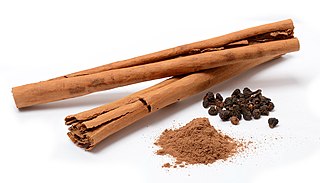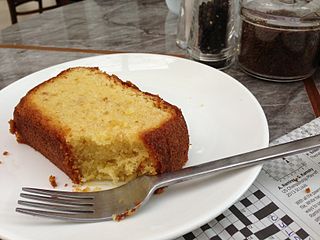
Cinnamon is a spice obtained from the inner bark of several tree species from the genus Cinnamomum. Cinnamon is used mainly as an aromatic condiment and flavouring additive in a wide variety of cuisines, sweet and savoury dishes, breakfast cereals, snack foods, bagels, teas, hot chocolate and traditional foods. The aroma and flavour of cinnamon derive from its essential oil and principal component, cinnamaldehyde, as well as numerous other constituents including eugenol.

Garam masala [from Hindustani گرم مصالحہ/गरम मसाला ] is a blend of ground spices originating from India. It is common in Indian, Pakistani, Nepalese, Bangladeshi, Sri Lankan and Caribbean cuisines. It is used alone or with other seasonings.

Semolina is coarsely milled durum wheat mainly used in making couscous, pasta, and sweet puddings. The term semolina is also used to designate coarse millings of other varieties of wheat, and sometimes other grains as well.

A king cake, also known as a three kings cake, is a cake associated in many countries with Epiphany. Its form and ingredients are variable, but in most cases a fève such as a figurine, often said to represent the Christ Child, is hidden inside. After the cake is cut, whoever gets the fève wins a prize. Modern fèves can be made of other materials, and can represent various objects and people.

The spice trade involved historical civilizations in Asia, Northeast Africa and Europe. Spices such as cinnamon, cassia, cardamom, ginger, pepper, nutmeg, star anise, clove, and turmeric were known and used in antiquity and traded in the Eastern World. These spices found their way into the Near East before the beginning of the Christian era, with fantastic tales hiding their true sources.

Fruitcake is a cake made with candied or dried fruit, nuts, and spices, and optionally soaked in spirits. In the United Kingdom, certain rich versions may be iced and decorated.

Rice pudding is a dish made from rice mixed with water or milk and other ingredients such as cinnamon, vanilla and raisins.

Sri Lankan cuisine is known for its particular combinations of herbs, spices, fish, vegetables, rices, and fruits. The cuisine is highly centered around many varieties of rice, as well as coconut which is a ubiquitous plant throughout the country. Seafood also plays a significant role in the cuisine, be it fresh fish or preserved fish. As a country that was a hub in the historic oceanic silk road, contact with foreign traders brought new food items and cultural influences in addition to the local traditions of the country's ethnic groups, all of which have helped shape Sri Lankan cuisine. Influences from Indian, Indonesian and Dutch cuisines are most evident with Sri Lankan cuisine sharing close ties to other neighbouring South and Southeast Asian cuisines.

Christmas cake is a type of cake, often fruitcake, served at Christmas time in many countries.
Mithai (sweets) are the confectionery and desserts of the Indian subcontinent. Thousands of dedicated shops in India, Bangladesh, Nepal, Pakistan and Sri Lanka sell nothing but sweets.

Somali cuisine is the traditional cuisine of Somalis from the Horn of Africa. Somali cuisine does have moderate foreign influence from different countries mainly due to trade but traditionally also varies from region to region due to the expansive landmass Somalis inhabit with traditions varying in different regions which makes it a fusion of differing Somali culinary traditions. It is the product of Somalia's tradition of trade and commerce. Some notable Somali delicacies include Kimis/Sabaayad, Canjeero/Lahoh, Xalwo (Halwa), Sambuusa (Samosa), Bariis Iskukaris, and Muqmad/Odkac.

Watalappam is a coconut custard pudding made of coconut milk or condensed milk, jaggery, cashew nuts, eggs, various spices, including cardamom, cloves, and nutmeg, and sometimes thick pandan juice or grated vanilla pods.

Bolo de mel is a traditional cake from the Madeira Islands.
Breudher, also known as Brueder or Bloeder, is a traditional Sri Lankan Dutch Burgher buttery yeast cake, baked in a fluted mould. A variation, Bleuda, Kueh Bleuda or Kue Bludder is also found in the Malacca Dutch Eurasian community and in Kochin, a city in the south-west of India.

Bibikkan is a traditional Sri Lankan coconut cake. It is a dark moist cake made of shredded coconut, jaggery and semolina combined with a mixture of spices. Bibikkan is commonly prepared and consumed in celebration of festive and religious occasions, including Christmas, New Year's Eve, Sinhala and Tamil New Year.

Sugee cake is a cake made of semolina and almonds, creamed butter, eggs, and brandy, and optionally covered in marzipan and royal icing. The cake is typically baked during festive occasions and holidays like Christmas, by members of Malaccan Portuguese in Malacca and the larger Eurasian community in Malaysia and Singapore. The word sugee has its origins in Hindustani word for 'semolina'. Sugee cake is similar to the Sri Lankan Love cake baked during Christmas by the Eurasian Burgher people, which uses cashew as opposed to almonds.[9]
Thuna paha is a Sri Lankan curry powder. It is a Sinhalese unroasted curry powder used to spice the curry dishes, especially vegetarian dishes. The name Thuna Paha roughly translates as "three or five" as traditionally it is made from three to five ingredients.

Bolo Fiado, or Bolo Folhado, is a Sri Lankan laminated/layer cake. It is made of sweet pastry layers, alternating with a cashew nut, sugar and rose water filling. It has the appearance of a thick Mille-feuille or large Danish pastry.















